Wow! You look great!
Hey skinny lady!
Who’s that in the picture?
It almost never fails. Every time I post a pic of myself on Facebook or some other social media outlet, these are the comments I get from friends and family back home. Since first moving to Spain for a 6-month stint in 2014, and after living here for almost another 8 months, I’ve lost quite a bit of weight. I’ve never been one to track my weight (scales, schmales), so I’m not exactly sure how much I’ve lost (that 15lbs in the title was really just a guesstimate); but I do know that not only have I dropped a couple of dress sizes, I also feel a lot better about my body – the way it looks, feels, and how it serves me as I go about my daily business. And get this: I’ve never once been to the gym.
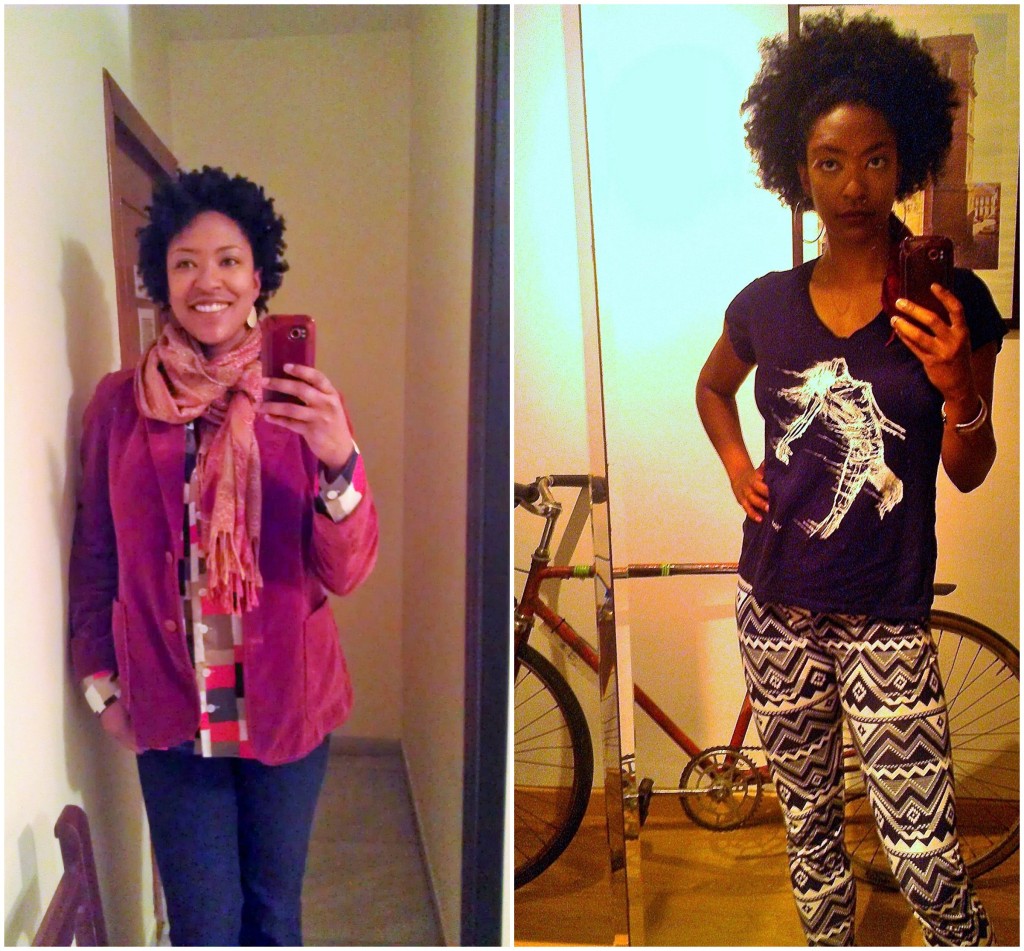
Before I have you thinking that I’ve slimmed down to the point of having no body issues at all, let me tell you: I’ve still got quite a little pooch going on, I still have minor anxiety sporting a two-piece on a beach full of super-fit Europeans, and, at over 35 years old, I’ve got bits that are jiggling and swaying way more than they ever did (or should). Still, more often than not, I like what I see looking back at me when I look in the mirror, and I know for certain that it has a lot to do with abandoning my American eating and living habits and adopting a more Spanish or European lifestyle. Namely:
Smaller restaurant portions
Though I eat all the things I try to avoid when eating out at home – like taters, bread, and pasta – and I drink like there’s no tomorrow, I’ve still managed to shed pounds. Part of this is because the amount of these things that I consume in a sitting is much less than what I’d consume in the States. The US is notorious for its ridiculous portion sizes. If you order a meal for one in a typical US dining establishment, you’re usually presented with enough food for 2 people. Ditto for drinks – especially sodas and beers. Here in Spain, the tradition of tapas – or small plates of food that are meant to be eaten in a few bites – makes it easy to have a filling meal with lots of variety, yet not overeat. One of my favorite Spanish portion control options is the caña – which is basically a half-sized serving of beer. Even when I go out and have multiple rounds of beers, I’m still only drinking half as much as I would if I did the same in the States.
Several small meals a day
My typical daily eating pattern in Spain goes something like this…
For breakfast (before 11am): Coffee and/or water.
Post-breakfast / Pre-lunch (between 11am and 2pm): A piece of fruit or, occasionally, a small pastry or slice of Spanish tortilla.
For lunch (between 2 and 3pm): A quick, home-cooked meal like a pasta dish, a big salad, or a meat-and-veggie dish.
Post-lunch: A piece of fruit or two for an after-lunch dessert or snack.
For dinner (between 8 and 10pm): A couple of rounds of drinks and accompanying free tapas or another quick, home-cooked meal.
I’ve adopted this pattern of eating after observing and eventually falling in line with the way I’ve seen the folks around me eat. The concept of eating several small meals a day isn’t unique to Spain. In fact, most nutritionists and weight loss experts in the US recommend this method of eating. Still, it isn’t the norm for the average American. We’ve been indoctrinated with the idea that you should eat ‘3 square meals’ a day – a hearty breakfast, a hearty lunch, and an especially hearty dinner – and that’s pretty much how I used to eat back home (with the exception of the hearty breakfast). Here, lunch – not dinner – is often the biggest meal of the day, which leaves plenty of time to burn off the calories before settling in for the evening.
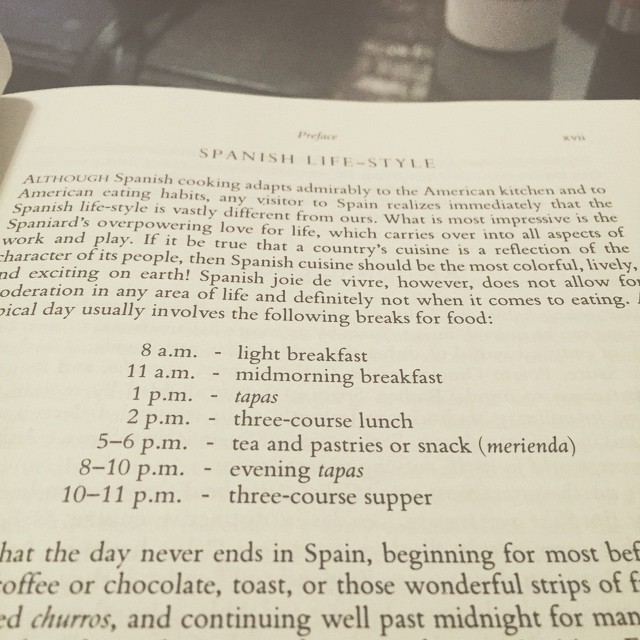
Lunch at home
You’ve probably heard of the Spanish siesta – that 2-3 hour lull in the middle of the day where everything shuts down and people go home to take a nap. While not everyone actually takes a nap during that time, almost everyone I know goes home for a home-cooked lunch. Having that large block of time to go home, prepare a healthy meal, eat it like a normal human (versus inhaling it like a vacuum cleaner), and let it digest a bit before heading back to work, is a luxury that I wish I had in the US. At home, I would barely have time to stuff some chicken fingers and fries (or a similarly unhealthy option) from the downstairs food court into my gullet before heading off to a meeting or rushing to meet an end-of-day deadline. Even on the days when I did go for a healthier lunch option, it was often more expensive to do so, and I’d end up resorting to the cheaper, less healthy lunch the very next day.
Coffee done right
Coffee is a known metabolism booster, and can help you burn extra calories IF you drink it the right way. What’s the right way? Well, ditching all the milk and sugar (I’m lookin’ at you, Starbucks), and drinking a small amount of black coffee or coffee with very little milk and sugar (like my beloved cortado) is a start. Also, it’s typical in Spain to have a coffee directly after or between meals, which is just when your body benefits from an extra boost of metabolism to help burn off the food you recently consumed.

Shared meals
In Spain, especially in smaller cities like the one I live in, eating is not a solo sport. Meals are meant to be shared – with friends, family members, coworkers, roommates. When you go out to eat with a group, it’s typical for everyone to share from common plates or to share bites of their individually ordered dish with everyone else at the table. At first, I turned my nose up at this practice. But… I want all my food for myself! But, I’m still hungry! But over time, I’ve adjusted. I’ve even noticed that the slower pace of eating in a group setting, helps me feel more full with less food. I’ve also noticed that Spaniards tend to share snack foods with folks around them. Whenever one of my colleagues has what we Americans would consider a single serving bag of chips or a similar snack, they always end up offering away at least a third of it to others, or eating about half and saving the rest for another time.

Walking
When I lived in the States, my work kept me sitting at a desk for multiple hours a day. After work, I’d walk 2 minutes to get in my car and drive home, where I’d often do more work sitting at a computer, before cooking dinner and watching TV or reading for a couple of hours before bed. Even if I ran errands in the neighborhood – like going to the grocery store that’s literally at the end of my street – it meant getting into my car and driving there. In the US, walking is often seen as a hardship or something that the less fortunate (i.e., those who can’t afford cars) do. The combination of a car-centric culture, and sprawling cities and neighborhoods, make walking for anything other than intentional exercise either unfashionable or implausible.
To put things in perspective, the entire country of Spain is smaller than the state of Texas (in square miles). The lack of sprawl makes walking a lot more feasible. Neighborhoods are designed so that you have almost everything you need within walking distance of your home – grocery stores, banks, schools, retail shops, personal services. And you’re not seen as odd or less fortunate if you walk everywhere, because almost everyone else – from infant to elderly – is walking too.
Water, water, everywhere
Because of all the walking I do, and because of a personal commitment to myself to consume more water, I almost always have a bottle of water on hand. I keep a 5L bottle of water in my room by my bedside, so I can not only track roughly how much water I drink a day, but also so I never have to go far to get it.
Biking
This is probably the single most influential factor in my weight loss. At the beginning of this school year, one of the professors at my high school was kind enough to loan me a bike to use during my time here. It just so happens that this bike is the oldest specimen of 2-wheeled locomotion ever known to man. It’s also a fixed gear, and it can leave my legs feeling like jelly even when riding on relatively flat terrain. Still, it’s a more efficient mode of transportation than walking, and I ride my rusty steed everywhere – to school, to the grocery store, to the park, to the library. I usually spend around 30-40 minutes biking each day, which isn’t a lot, but it’s definitely made a lot of difference.
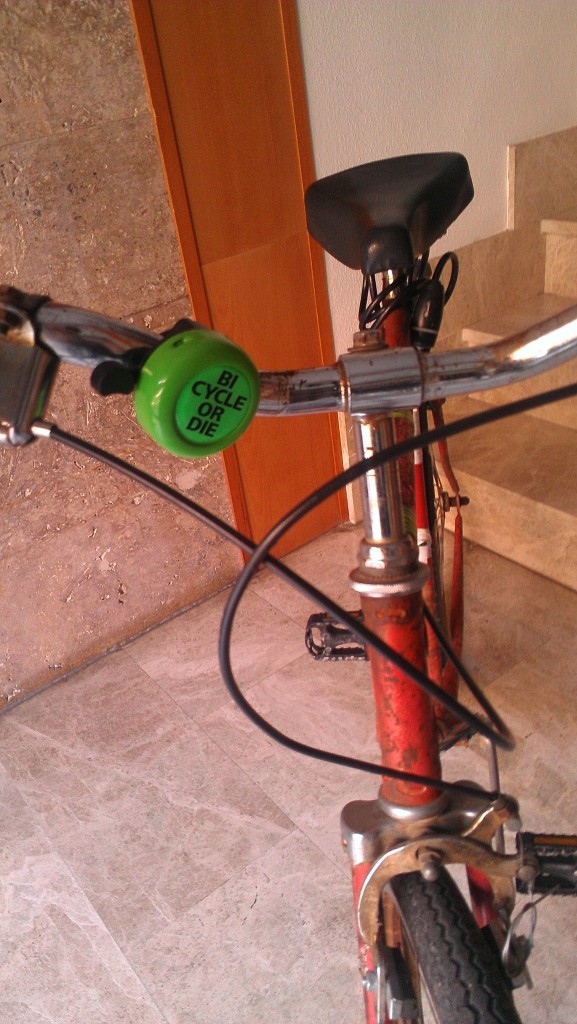
Easy access to healthy, cheap ingredients
Within a 3-5 minute walk in any direction from my apartment, I have a least 4 independently owned fresh fruit/veggie stands, and 2-3 chain grocery stores. The selection of produce in either of those outlets is generally less varied than what I’d find in the US, but the price and the quality is significantly better. And the fact that they’re so close and right in front of my face, makes it easier for me to grab a healthy snack versus the fast food that I’d normally go for back home.
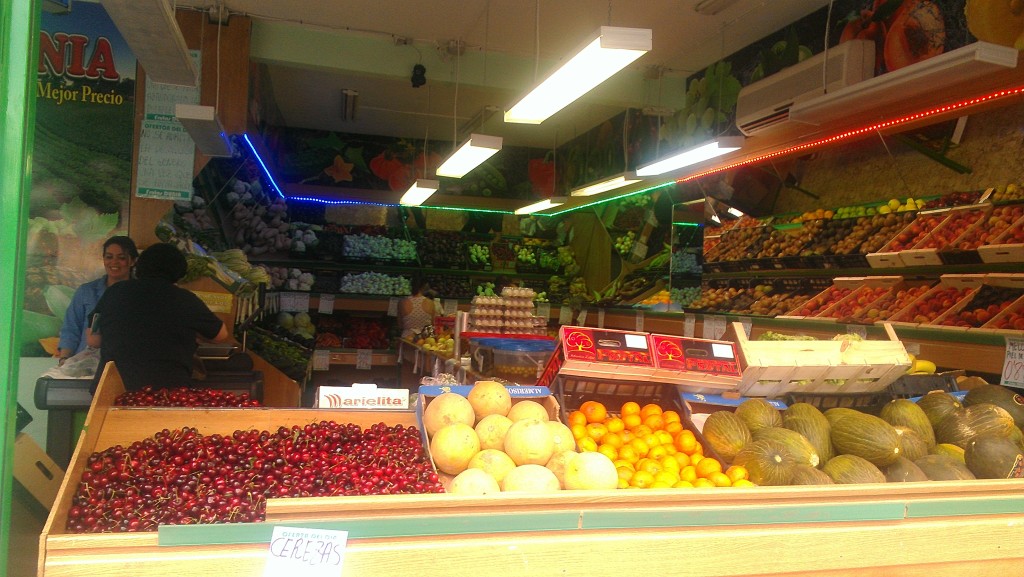
Fast food is an occasional treat
In the US, fast food is convenience food. Don’t have time to cook? Forgot to pack a healthy lunch? No problem. Just stop by one of the dozen fast food restaurants you’re sure to pass on your way to and from home and pick up an extremely high-calorie, extremely low cost meal. Fast food is so widely available and frequently consumed in the US, it could almost be considered its own food group. While I wasn’t a frequent consumer of fast food at home, I certainly ate my fair share of quick-serve lunches at work, and my go-to snack when on the run was an order of french fries from the nearest Chik-Fil-A or McDonald’s. Here, a trip to a fast food outlet is seen as a treat – something you do every once in a while as a special outing for the kids or yourself. And the prices reflect that. Going to Mickey D’s, KFC or Burger King is often an expensive proposition – a combo meal can run from 5 to 7 euros, and there’s rarely, if ever, a dollar menu. There are also fewer fast food locations to choose from. You almost have to go out of your way to get to one, and you’ll have to pass several cheaper, considerably healthier options to do so.
Now, are any of the above behaviors impossible to duplicate in the US? Absolutely not. Am I suggesting that there are no overweight or obese Spaniards? Nope. In either country, individual health and body weight are often a reflection of the daily lifestyle choices we make. But due to cultural norms, I think it’s more difficult to make these choices and stick to them on a regular basis back home in the US of A. As my time in Spain comes to an end, I often worry if I’ll be able to hold on to these healthy habits that I’ve picked up in my host country. I like to think that it’ll be easy, but I’m not 100% sure. For my own sake, and for the sake of my Facebook photo admirers, I certainly hope so. 🙂
Have you noticed any positive body changes during your travels or time living abroad? What do you think was behind it? Have you been able to stick to your healthy habits after returning to your home country?
Share your feedback in the comments!
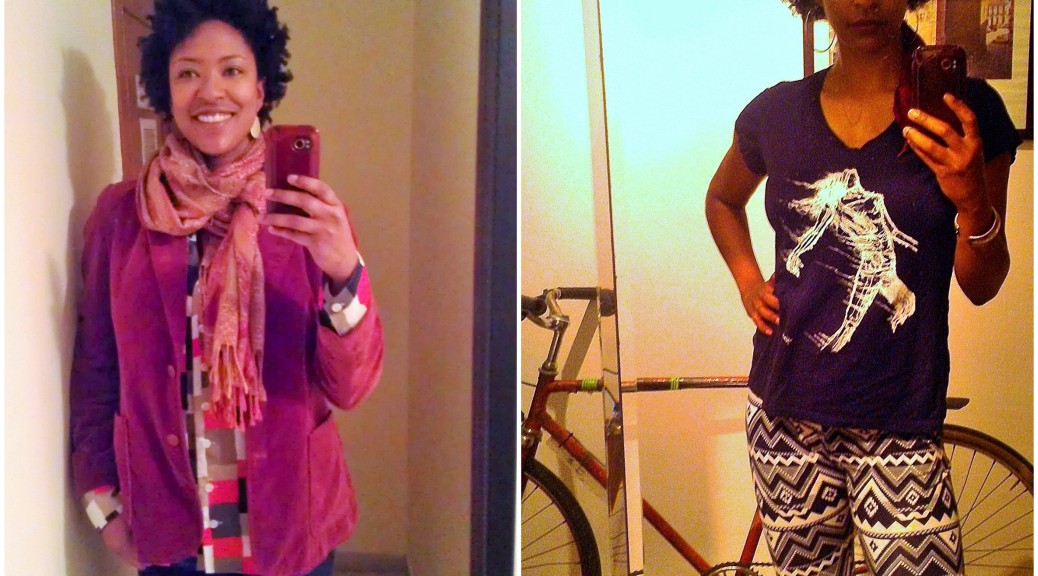
I absolutely loved reading this glimpse into your Spainaird life. You look amazing and I’m sure you’ll find a way to keep your new habits in tack once you arrive home! You are an inspiration to me…that expat life is calling me. Thanks so much for sharing KSolo!
Hey, Sunny!
Thanks so much! If expat life is calling… you better answer! Lol. But seriously, it’s worth the it – probably the best education on self and the world I could have ever hoped for.
Thanks a lot for the great post! I lived in Japan for an academic year and a half (three non-consecutive semesters, or 12 weeks each contract period) and each time I returned home 12-14 pounds lighter. This is because in Japan, similar to Spain, portion sizes in restaurants are significantly smaller than those in the US. Not just small, but child-size! Japan is about the size of California, but packed with nearly 130 million people, so there isn’t a lot of land for growing food. Therefore, food package sizes in supermarkets are much smaller as well, and very expensive. This forced me to buy less food, and eat less as well. This coupled with all the walking I did from my apartment to the train station to get to work everyday and the pounds melted off. I felt and looked great at this time–just lighter and more energized. Keeping the weight off once back in the States was another matter, though. Eating tiny portions of food when more was available to me was hard to maintain, and returning home in the winter around Christmas time with all the holiday goodies tempting me didn’t help either. But I think with planning and discipline, one can maintain some of the healthy habits adopted abroad.
Stephanie –
It’s amazing how little effort it takes to live healthy / lose weight once you adapt to the culture of your host country. I think you hit the nail on the head re: what it’ll take to maintain at home – planning and discipline. It won’t be as effortless, but it can definitely be done. Thanks for reading!
I totally just pinned this article. I’m gearing up to do the Military Diet and I came across this post on facebook. This is pretty similar in style and I would like to look more into eating tapas. There was a lot of people who were against the military diet saying it was like starving but after reading you post I realize it’s not and I should look into what works for me. You look beautiful by the way and your clothing style appears of have changed also. Are you a natural hair woman? and if so how do you maintain that in Spain? Thanks again, great read.
Hey Sonja –
I’d never heard of the military diet before – just looked into it briefly. Honestly, I don’t know that I’d be able to do that either. Diets have never appealed to me because I always think, ‘If I’m not interested in / able to eat this way forever, why start?’ Even now, I have days when I eat horribly (I had a bag of potato chips for dinner last night. Shameful.), but I always know I’m going to balance it with moderate physical activity (I also walked up 5 flights of stairs and took a 30-minute non-leisurely stroll through town yesterday), and days of eating really well (Today, it’s bananas and veggie stir-fry for breakfast & lunch, respectively). I agree that you have to go with what works for you, and not be too stringent or stick on one eating plan that you aren’t able to enjoy food on your own terms.
As for your hair question… yep I’m natural (~17 years now). Not hard for me to maintain here, since I’m pretty low maintenance when it comes to hair care. I brought a few styling products and a good conditioner from home, and I make use of natural, easy-to-find products like olive oil, coconut oil, argan oil (morocco is pretty close, thankfully), and – when i can find it – shea butter. During the winter months, I like to wear braid extensions (too hard combating the dry climate every day) since I lived in a small town this go ’round, I’d usually wait to get hair supplies / services when I travelled to a larger city, but all in all, it hasn’t been too difficult.
Thanks for reading!
Love reading your blog! Great and informative post. Now I know how I will spend my work day. LOL!
Thanks, Vanessa – glad you enjoy!
Loved your article! You pretty much said everything I knew to be true by talking to my few friends that have lived abroad. May I ask, what city do you live in in Spain? I’m debating doing a year long study abroad program through my school in Jaen, Spain, and I can’t find any information about this town/city-especially not anything about black people living there lol.
hey lauren –
thanks for reading! i’ve actually lived in a few cities – first marbella, then ciudad real, and now malaga. i actually have a friend – another black american woman – who lived in jaen province, in the small city of huelma for several months. not sure about the capital city, though. my friend wrote a blog about her experiences as well – it’s called La Morena de Andalucia. take a look at it and reach out to her to see if she can give you more insight on jaen.
Hi, I am moving to Malaga in 5 weeks!
Hi loved your food weight loss post so interesting
Think it basically comes down to the fact that the USA and uk are more unhealthy and fat nations
I was in France the southport last summer for only 2 weeks, but lost 7lbs and I drank wine every night
The walking and more fresher food was obviously a plus not to mention no fast food as stated by yourself
I’m moving to Spain in September and can’t wait to see any result
I will use some of these practical approaches. The urge to make some dietary changes is getting louder. Easy read… has your personality too. Been a minute since of gazed on any of your prose. Kenton
Great article!